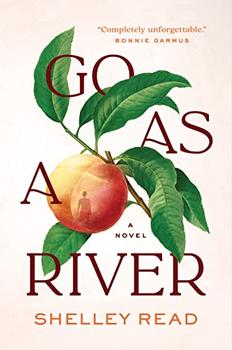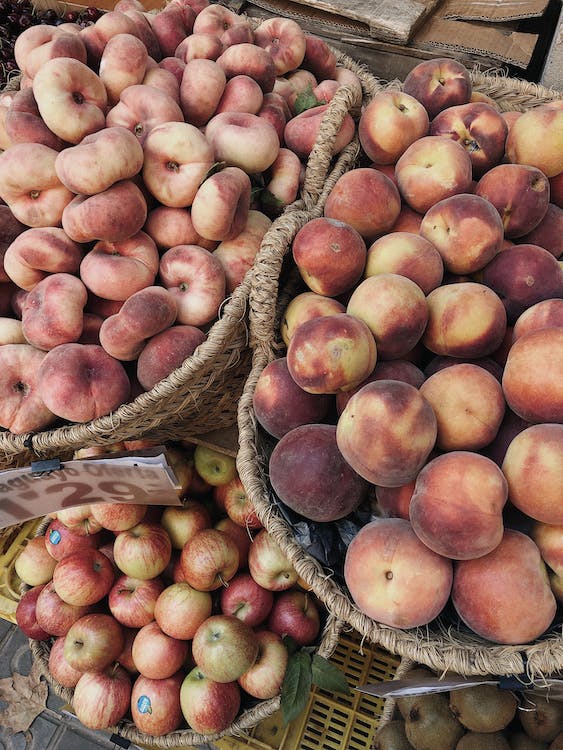Summary | Excerpt | Reading Guide | Reviews | Beyond the Book | Read-Alikes | Genres & Themes | Author Bio

A Novel
by Shelley ReadThis article relates to Go as a River
 In Shelley Read's debut novel, Go as a River, the heroine's life revolves around her peach farm in Colorado.
In Shelley Read's debut novel, Go as a River, the heroine's life revolves around her peach farm in Colorado.
Genetically the peach is part of the rose family, but its closest relative is the almond. Its genera, Prunus, also includes cherry, apricot and plum trees. While its formal name, Prunus persica, translates to "Persian plum," it's believed that peaches were first cultivated in China. Archeological evidence points to orchards in Zhejiang Provence as early as 6000 BCE.
Peaches spread across the globe over the ensuing millennia. While the fruit itself is relatively fragile, the seeds grow readily and are easily transported, making them easy to propagate. After becoming established in the Middle East, peaches arrived in Europe during the 4th century BCE, brought to the Mediterranean by Alexander the Great as a spoil of war. From there the fruit spread across Europe to Spain, eventually arriving in the New World with the Conquistadors in the 16th century.
Like apples, peaches develop vastly different characteristics from tree to tree, and before grafting peach trees became common, the fruit wasn't considered a reasonable cash crop. The quality of the flesh – flavor, texture, hardiness – varied so much that it wasn't practical to market peaches in quantity, plus the fruit's relatively short shelf life meant it didn't transport well. Instead, through the 19th century, farmers in the southern United States used peaches as hog feed, or fermented them into brandy. Wild peach fruit was a key form of sustenance for people escaping enslavement.
Large-scale, commercial orchards began to take off in the United States in the 19th century, and between 1889 and 1924 the number of peach trees in the country grew more than fivefold. Today there are over 300 peach varieties in the US alone (including the nectarine, which is actually just a fuzzless peach). All peaches fall into two main categories: clingstone and freestone. Clingstone peaches, where the fruit is firmly attached to the pit, are more challenging to eat but are generally sweeter and juicier. With freestone peaches, the pit almost falls away from the fruit, making them preferred for cooking and baking. (A newer hybrid, semi-freestones, is purported to be the best of both worlds.) Peaches also come in a variety of flesh tones (white, yellow, red) and sizes (such as dwarf and doughnut). All are relatively low calorie, high in fiber, rich with zinc, and a good source of vitamins A and C.
In the United States, peaches are associated with Georgia, but the state only produces about 24,800 tons annually — about 2%-5% of the country's peach crop. California orchards grow about two-thirds of the nation's total 625,000 tons. Colorado, where the peach orchard in Go as a River is located, only produces around 15,000 tons a year. China remains the largest peach producer in the world at 17 million tons, with Italy being a distant second at just 1.5 million tons.
Peach consumption in the United States is down significantly in recent decades. According to Statistica, "The U.S. per capita consumption of fresh peaches amounted to approximately 1.94 pounds in 2022. The consumption of fresh peaches and nectarines has reduced by over 60 percent in the U.S. since 2000, when consumption was at about 5.3 pounds per person." It's widely believed that the drop is the result of an increase in the price of peaches, in part driven by years of poor crops due to global climate change.
Filed under Nature and the Environment
![]() This article relates to Go as a River.
It first ran in the December 6, 2023
issue of BookBrowse Recommends.
This article relates to Go as a River.
It first ran in the December 6, 2023
issue of BookBrowse Recommends.
Your guide toexceptional books
BookBrowse seeks out and recommends the best in contemporary fiction and nonfiction—books that not only engage and entertain but also deepen our understanding of ourselves and the world around us.